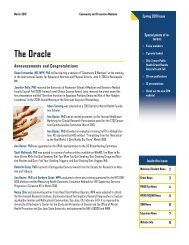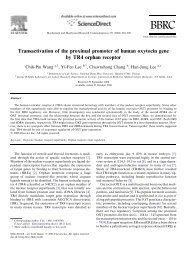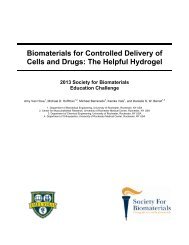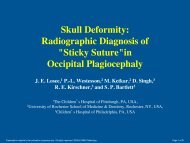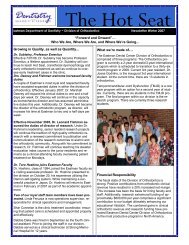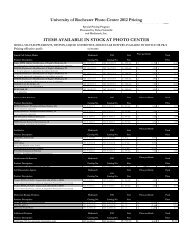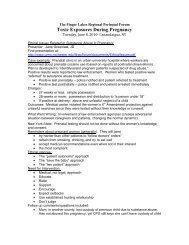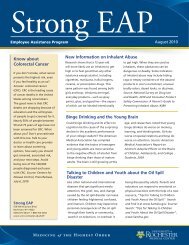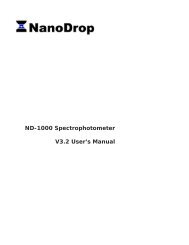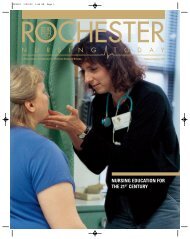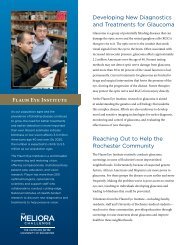Fall/Winter 2006 - University of Rochester Medical Center
Fall/Winter 2006 - University of Rochester Medical Center
Fall/Winter 2006 - University of Rochester Medical Center
Create successful ePaper yourself
Turn your PDF publications into a flip-book with our unique Google optimized e-Paper software.
Questions for the new CEO<br />
Why did you want the CEO position<br />
This is a great opportunity. These are<br />
exciting times. The <strong>University</strong> <strong>of</strong><br />
<strong>Rochester</strong> <strong>Medical</strong> <strong>Center</strong> has a long<br />
tradition <strong>of</strong> excellence in our missions.<br />
As an alumnus <strong>of</strong> the School <strong>of</strong><br />
Medicine and Dentistry, I want to<br />
continue that tradition. In particular,<br />
this is an opportunity to build on our<br />
strengths that have accrued over the last<br />
eight years. The two new research buildings<br />
have given us an enormous increase<br />
in our NIH funding and our faculty.<br />
It’s an exciting time for research in<br />
biomedical science, in particular for<br />
interdisciplinary programs. You can see<br />
this in the biomedical engineering and<br />
optics building now under construction<br />
and the centers <strong>of</strong> research that have<br />
emerged in the <strong>Medical</strong> <strong>Center</strong>. Many<br />
are deeply interdisciplinary. So I think<br />
this is an excellent time to build on our<br />
strengths <strong>of</strong> collaboration and basic<br />
research. In addition, the NIH and the<br />
public really want basic science to be<br />
translated into clinical therapies.<br />
We have a terrific <strong>Medical</strong> <strong>Center</strong><br />
in terms <strong>of</strong> delivering health care.<br />
We have outstanding physicians who,<br />
because we’re all in one building,<br />
communicate with investigators. This<br />
creates many opportunities to translate<br />
basic research into clinical benefits.<br />
Just consider the development <strong>of</strong> the<br />
human papillomavirus vaccine, a superior<br />
example <strong>of</strong> how basic research gets<br />
translated into a huge benefit, essentially,<br />
the prevention <strong>of</strong> a cancer.<br />
We now also are the largest<br />
employer in the community, and that<br />
carries with it a responsibility for<br />
economic development. I personally will<br />
put quite a bit <strong>of</strong> energy into improving<br />
the entrepreneurial spirit <strong>of</strong> the<br />
<strong>University</strong>, fostering programs that can<br />
result in spin-<strong>of</strong>f companies, development<br />
<strong>of</strong> intellectual property and<br />
creation <strong>of</strong> jobs in <strong>Rochester</strong>.<br />
Do you see growth at the <strong>Medical</strong><br />
<strong>Center</strong><br />
We must facilitate bed access to improve<br />
our patient care services. So, we are<br />
planning to add 20 beds in the next<br />
18 months, probably 60 beds in the next<br />
three years. In addition, we must plan<br />
for increases in ambulatory surgery and<br />
medicine. To continue to attract the best<br />
scientists, we must <strong>of</strong>fer superb research<br />
space. I’d like to see us add between<br />
250,000 and 400,000 square feet <strong>of</strong> space<br />
over the next 10 years. To focus and prioritize<br />
these needs, during the next year we<br />
are going to continue a very intensive<br />
strategic planning process. There are many<br />
exciting areas that I would like to emphasize<br />
as we build new programs — aging,<br />
cognitive dysfunction, obesity, regenerative<br />
medicine, stem cells, and nanotechnology,<br />
to name a few. These are all<br />
areas, where, looking 10 years down the<br />
road, there are going to be huge needs or<br />
huge opportunities for more effective therapies.<br />
By setting into place research and<br />
clinical programs today, we’ll be leaders<br />
10 years from now.<br />
As an alumnus and a native <strong>of</strong> the<br />
<strong>Rochester</strong> area, do you bring a special<br />
perspective to the <strong>Medical</strong> <strong>Center</strong><br />
Absolutely. As people say, if you’ve seen<br />
one medical center, you’ve seen one.<br />
Each is unique. <strong>Rochester</strong> has many<br />
unique traditions <strong>of</strong> its own. It’s the<br />
home <strong>of</strong> the biopsychosocial model <strong>of</strong><br />
Morgan and Engel. The fact that all<br />
research and clinical operations are<br />
under one ro<strong>of</strong> is a very special part <strong>of</strong><br />
this place. The imprint <strong>of</strong> George Hoyt<br />
Whipple from 1925 lives on. You can see<br />
the very bricks <strong>of</strong> the hospital that he<br />
built right outside my <strong>of</strong>fice. There’s a lot<br />
<strong>of</strong> tradition here. And as a student, you<br />
come to respect that tradition. I personally<br />
have known six <strong>of</strong> the seven deans<br />
<strong>of</strong> the School <strong>of</strong> Medicine. Dr. Whipple<br />
died when I was a first-year student.



